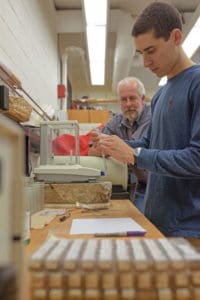Helping Connecticut Homeowners
Environmental Science Program faculty and students address crumbling concrete foundations.
The laboratories in Trinity College’s Environmental Science Program were buzzing with activity this summer as students and faculty members conducted tests on samples of concrete foundations, searching for the presence of the mineral suspected of causing basements across northeastern Connecticut to crumble.
Working with the grassroots organization Connecticut Coalition against Crumbling Basements (CCACB), Trinity faculty members have developed more affordable and definitive tests for the mineral pyrrhotite [PEER-row-tight], which has proven difficult to detect in concrete core samples. This service is beneficial to homeowners whose foundations are showing signs of deterioration or those whose homes may be at risk.
Jonathan Gourley, senior lecturer and laboratory coordinator in the Environmental Science Program, and Professor of Environmental Science and Physics Christoph Geiss, who also serves as director of Trinity’s Environmental Science Program, said that their method involves testing for pyrrhotite based on its magnetic properties. “The application is new,” Geiss said, “but the technique is not.” The result, Gourley added, is that “we have created a test that is more reliable for homeowners, and we can do it at a lower cost than what engineers were charging.”
According to Tim Heim, founder of the CCACB, up to 33,000 homes may be affected. “We’ve got to test these homes and find out what the scope of the problem is,” he said. There is no way to repair the crumbling concrete; the only remedy is to replace the entire foundation, which could cost more than the home is worth and often is not covered by insurance. With homeowners facing so many challenges and costs, Heim said he is grateful to the Trinity scientists for developing this less expensive method of testing for pyrrhotite. Through the Capitol Region Council of Governments (CRCOG)—a federation of towns in the Hartford region—homeowners can be reimbursed for 50 percent of the testing costs up to $2,000, Heim says. “With the CCACB and Trinity in their partnership doing coring samples and testing, the cost will be $1,900, which is below that maximum,” he said. “Before this, the testing could cost $3,000 or $4,000.”
Homes currently showing signs of crumbling basements are largely concentrated in northeastern Connecticut around a quarry in the town of Willington where the pyrrhotite-rich pieces of rocks used in the concrete mixture originated. Heim said that homes built from the early 1980s up to 2017 could be impacted and noted that homeowners would want their foundations tested for pyrrhotite for many reasons. If the concrete is already showing signs of cracking, a positive result can make the homeowner eligible for grants funded by the state government. Concrete with pyrrhotite could take years to show signs of cracking, so a negative result can bring peace of mind to homeowners and reassurance about the longevity of the foundation to banks, real estate agents, home inspectors, and insurance companies.

The CCACB manages the collection of the samples, and Trinity faculty and students complete the testing and provide written reports. “We involve our students in everything,” Gourley said. “They do fieldwork, collect samples, and contribute to the research.”
Joe Ruggiero ’19, an environmental science major and history minor from Manchester, Connecticut, has been working to determine the lowest concentration of pyrrhotite that will affect concrete. “Several of my neighbors have experienced extensive cracking, so I have seen the financial burden that this issue carries,” Ruggiero said. “I believe creating a cost-saving, comprehensive guide for homeowners will ultimately reduce the stress on families and lead to better legislation protecting homeowners.”
Sam March ’21, an environmental science major from Glastonbury, Connecticut, is gathering rock samples from across the state to test their pyrrhotite and sulfur concentrations. “This project motivates me because it’s applicable to the real world,” March said. “I believe that as this research progresses, we can begin to explain why basements are crumbling and eventually prevent this from happening in the future.”
Geiss and Gourley estimate that with the help from students, Trinity can process five to 10 concrete foundation core samples per week. Geiss said, “It’s a perfect combination of scholarship, teaching, and outreach to the community because we are providing a service that did not exist and that may help people quite significantly.” They hope to teach their methods to engineering firms and inspectors who will continue to run these tests.
The two attended a community forum in Ellington, Connecticut, in November 2017 when they told concerned homeowners about their testing methods and the new partnership between Trinity and CCACB. Heim said, “It’s been an honor working with Trinity and with Christoph and Jonathan. They have such passion in creating a more affordable means of testing so that the victims are not victimized again.”
Written by Andrew J. Concatelli
Christoph Geiss Professor of Environmental Science and PhysicsIt's a perfect combination of scholarship, teaching, and outreach to the community because we are providing a service that did not exist and that may help people quite significantly.

